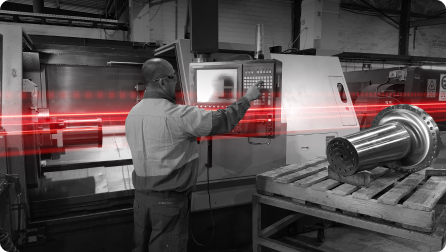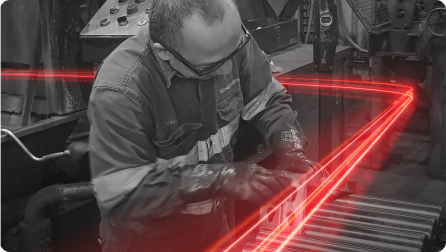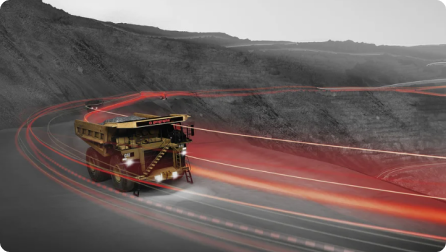
Approached by Western Australian salt producer and global exporter, Dampier in 2010, Geographe was asked to solve the challenge of replacing seized and corroded wheel nuts on its Caterpillar fleet impacted by running continuously in saltwater conditions.The result was the Geographe Industrial Nut Splitter - an easy to use, lightweight hydraulic splitting tool allowing the wheel nuts to be quickly cut off a machine without damaging the wheel studs.
With the industrial nut splitter being the first commercial piece of tooling created for customer use, Geographe’s Specialised Tooling team was founded.

Fast forward to 2017, and the Geographe team had received a call from the workshop of Fortescue Metals Group regarding a maintenance challenge on their Caterpillar haul truck fleet – the removal of the ball studs in the steering arms.
If you’ve ever maintained a Caterpillar haul truck, you may have come across a particularly stubborn ball stud which forms part of the steering assembly.
By no one’s fault other than a dusty and harsh work environment, these ball studs can become effectively welded in position, requiring some real grunt work to remove them for routine maintenance.
After one particularly difficult stint removing a ball stud, FMG’s maintenance team called Geographe’s Research, Development and Innovation Manager, Sean Martin to leverage his team’s many years of industry experience and knowledge.
“They had a situation where it had taken two shifts (up to 24 hours) to remove one ball stud,” Martin said.
“You can imagine the downtime of having a truck parked up in a workshop for that amount of time – it must have been extremely frustrating.”
After almost three decades in the industry, Martin says he’d never heard of the issue, but his team was up for trying to resolve the significant challenge.
He says the real issue was in the lack of effective tools to remove the stubborn studs, with usual processes requiring more brawn than brain.
“Traditional methods of removing them sometimes just don’t work to the point where they often need to be lanced (cut) out.” Martin says.
“It starts to get dangerous, very noisy and there’s a lot of potential for damaging other steering components around the ball stud. Basically, it can be an all-round nightmare for maintenance teams.”
The solution, after several iterations of research and development, was Geographe’s patented Ball Stud Removal Tool (BSRT), a hydraulic pressing tool designed for a one-person operation that could also be used in a workshop and field breakdown scenarios.

When using the BSRT, Geographe received feedback from South32 that they managed to remove four ball studs in just 20 minutes on a Caterpillar 785 – a mammoth time saving compared with one shift (approx. 8 hours) per stud that was originally reported by FMG.
The ball studs in question can be found on seven models in Caterpillar’s haul truck range – the 773, 777, 785, 789, 793, 795 and 797. The Geographe BSRT is currently applicable to suit the 785, 789 and 793 trucks, with an additional variant to fit the 777 truck scheduled for release soon.
Martin says the tool has received terrific support in Australia while also being available in Indonesia, South America, the United States, Canada and regions of Africa.
“We’ve started with the most prevalent machines in Australia but will develop tools for other trucks in the series and apply a more global fleet-centred approach. We’re getting a lot of interest from overseas, particularly from the United States and Canada on the larger trucks.”
Geographe has made the BSRT from a forged high-tensile alloy, which then receives further heat treatment to ensure its reliability in a high-stress environment.
Martin describes the process of developing the BSRT for a very specific application.
“It had to be fairly quiet, there shouldn’t be any impact required, it shouldn’t damage anything else around it and the ball stud should be reusable,” he says.
“The aim was that if a ball stud was removed, crack checked, cleaned, and they wanted to put it back in, they could do so. All these boxes were ticked with the final design.”
The difficulty in developing such a tool – to be used in a tight space under the truck – was in its weight, mobility, and ability to fit between the truck’s steering control arms and the bell crank.
“We had about 17 millimetres for the fingers of our tool to slide into and up to 50 tonnes of applied force was on these fingers. So, the material needs to be very strong and resistant to fatigue over extended use.”

To ensure the strength of the tool, Geographe implements a Finite Element Analysis (FEA) using a computer program to understand how reliable the product is under stress.
“The loads, dimensions of the tool and the materials are entered so that the program can understand where the load is distributed and where any weak points in the tool might be”, Martin explains.
“Product Development Manager Nick Pyper and former Product Designer Jamal Barikbin were pivotal in co-designing a tooling solution which has helped our customers succeed in meeting their site targets with Innovation Project Manager Ryan Hyder being instrumental in the ongoing development of the tool’s variations, including one to suit 793 trucks fitted with Extended Life Brake Packs.”
See www.geographe.com.au/bsrt for more information on the Ball Stud Removal Tool and Enhanced Performance Ball Studs.
Be abreast of Enhanced Performance Solutions for Mining Parts
How can we help?
Submit your details below and our team will contact you.







